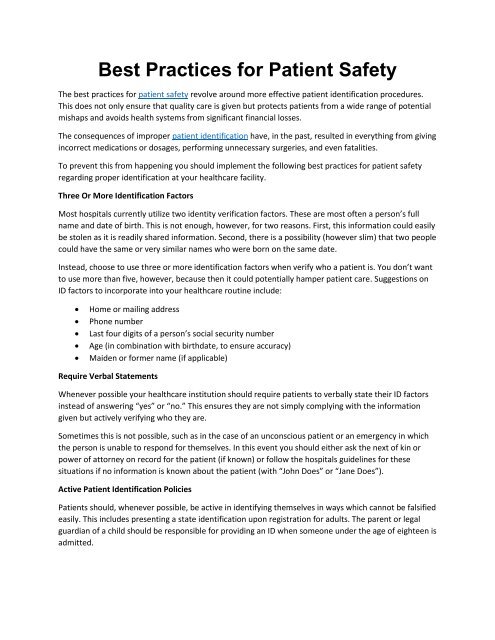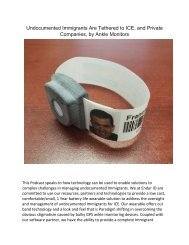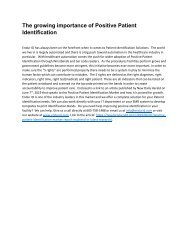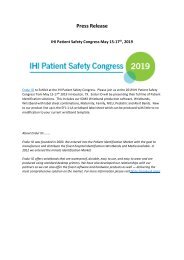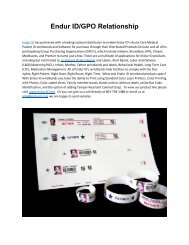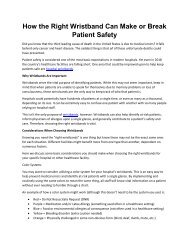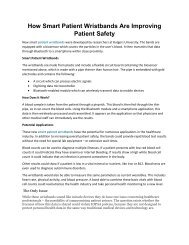Best Practices for Patient Safety
The best practices for patient safety revolve around more effective patient identification procedures. This does not only ensure that quality care is given but protects patients from a wide range of potential mishaps and avoids health systems from significant financial losses. Visit: http://endurid.com
The best practices for patient safety revolve around more effective patient identification procedures. This does not only ensure that quality care is given but protects patients from a wide range of potential mishaps and avoids health systems from significant financial losses. Visit: http://endurid.com
You also want an ePaper? Increase the reach of your titles
YUMPU automatically turns print PDFs into web optimized ePapers that Google loves.
<strong>Best</strong> <strong>Practices</strong> <strong>for</strong> <strong>Patient</strong> <strong>Safety</strong><br />
The best practices <strong>for</strong> patient safety revolve around more effective patient identification procedures.<br />
This does not only ensure that quality care is given but protects patients from a wide range of potential<br />
mishaps and avoids health systems from significant financial losses.<br />
The consequences of improper patient identification have, in the past, resulted in everything from giving<br />
incorrect medications or dosages, per<strong>for</strong>ming unnecessary surgeries, and even fatalities.<br />
To prevent this from happening you should implement the following best practices <strong>for</strong> patient safety<br />
regarding proper identification at your healthcare facility.<br />
Three Or More Identification Factors<br />
Most hospitals currently utilize two identity verification factors. These are most often a person’s full<br />
name and date of birth. This is not enough, however, <strong>for</strong> two reasons. First, this in<strong>for</strong>mation could easily<br />
be stolen as it is readily shared in<strong>for</strong>mation. Second, there is a possibility (however slim) that two people<br />
could have the same or very similar names who were born on the same date.<br />
Instead, choose to use three or more identification factors when verify who a patient is. You don’t want<br />
to use more than five, however, because then it could potentially hamper patient care. Suggestions on<br />
ID factors to incorporate into your healthcare routine include:<br />
<br />
<br />
<br />
<br />
<br />
Home or mailing address<br />
Phone number<br />
Last four digits of a person’s social security number<br />
Age (in combination with birthdate, to ensure accuracy)<br />
Maiden or <strong>for</strong>mer name (if applicable)<br />
Require Verbal Statements<br />
Whenever possible your healthcare institution should require patients to verbally state their ID factors<br />
instead of answering “yes” or “no.” This ensures they are not simply complying with the in<strong>for</strong>mation<br />
given but actively verifying who they are.<br />
Sometimes this is not possible, such as in the case of an unconscious patient or an emergency in which<br />
the person is unable to respond <strong>for</strong> themselves. In this event you should either ask the next of kin or<br />
power of attorney on record <strong>for</strong> the patient (if known) or follow the hospitals guidelines <strong>for</strong> these<br />
situations if no in<strong>for</strong>mation is known about the patient (with “John Does” or “Jane Does”).<br />
Active <strong>Patient</strong> Identification Policies<br />
<strong>Patient</strong>s should, whenever possible, be active in identifying themselves in ways which cannot be falsified<br />
easily. This includes presenting a state identification upon registration <strong>for</strong> adults. The parent or legal<br />
guardian of a child should be responsible <strong>for</strong> providing an ID when someone under the age of eighteen is<br />
admitted.
Also have patients read their wristbands upon receiving them. This checks that no errors have been<br />
made during the registration process in terms of identifying in<strong>for</strong>mation. Alternatively, patients could be<br />
asked to read the in<strong>for</strong>mation on the registrar’s screen prior to wristbands being printed.<br />
Photographic Evidence<br />
One way to help further prevent medical identification fraud is to have hospitals take photographs of<br />
patients during the registration process. This is already being implemented in other fields, such as<br />
banking and check cashing facilities.<br />
It takes just a second to snap a photograph. This can be quickly compared to a patient upon each new<br />
visit to ensure that nobody is trying to pretend they are someone they are not.


